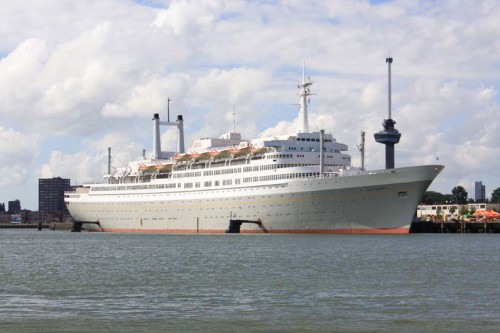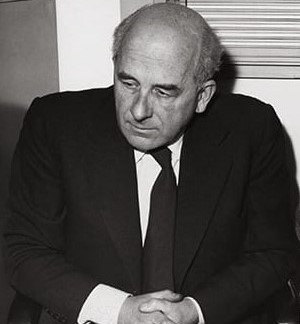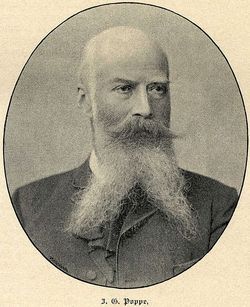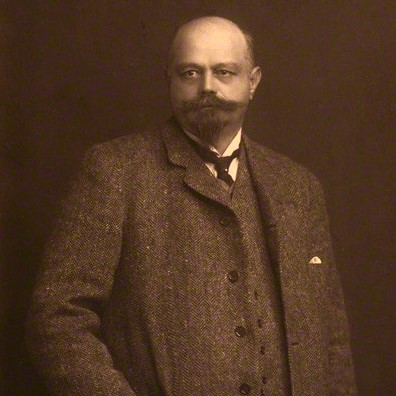On Oct 27th 1955, the Holland America Line (HAL) placed an order at the Rotterdamse Droogdok Maatschappij, a shipyard in Rotterdam, the Netherlands, which mainly repaired and overhauled ships as its core business. However, occasionally the yard also built vessels completely from scratch.
HAL had had plans for a running mate and eventually a successor to the Nieuw Amsterdam as soon as this vessel was delivered in 1938. At first HAL’s own design department came up with several very streamlined design studies all of which had a strong resemblance to the Nieuw Amsterdam. Even a model with three funnels was produced (in the end the Rotterdam would have no funnels at all!). HAL contacted the RDM and together a design emerged of a graceful vessel with a pronounced sheer. The ship had to be able to carry passengers in two classes on its Transatlantic voyages from Roterdam to New York and switch to one class when cruising. So differences between the two classes when she would sail in liner service had to be minimal.

As mentioned already, the new HAL flagship would have no funnel. Midships, a structure was built on her top deck which showed a resemblance to a funnel, but in reality it was used as a bar. Instead of the old fashioned funnel, twin uptakes were placed aft.
Four men played a key role in the overall design of the ship: head of the design department of the HAL mr. Van Veen, mr. van Engelen who was HAL’s leading architect, mr. Stapel head engineer of the RDM-yard and HAL president mr. de Monchy who had a keen interest in the new ship’s interiors.
In 1952 HAL had begun serious negotiations with RDM and the first designs were completed. This was an on and off process which was interrupted when RDM’s competitor the Wilton Feyneoord shipyard presented HAL a design of a 20.000GRT passenger vessel which would cost half as much as the planned successor of the Nieuw Amsterdam would.
In 1954 the HAL and the RDM resumed the design phase of the new HAL flagship
Finally, on Dec. 15th 1956 construction of the ship was started. During an official ceremony the first two sections were placed on the slipway. Work on yard no. 300 had actually begun. It took 21 months to build the vessel. The empty hull of the ship was heated in several places so workers could continue working on the ship throughout the winter. Two elevators could carry workers and material to a height of 30m. On the ships bottom a railroad was built to carry heavy machinery parts and electrical equipment to its desired location in the vessel.
After 21 months the ship was ready to be launched and HRH the Queen of the Netherlands Juliana christened her on Sept. 13 1958. It was a sunny day and 60,000 spectators watched the ship slide into the river Maas. The Queen named her Rotterdam and the bottle of Champagne smashed against her bows.

Now the next stage of fitting out started. Her interiors started to take shape,: over 1400 people worked onboard. The Rotterdam was docked in the brand new RDM drydock on Dec 9th for “the finishing touch” and on July 11th she left Rotterdam for her first trials. She sailed from Rotterdam via Hook of Holland for her first sea trials, and also to IJmuiden twice. She performed very well and proved to be a stable ship with excellent seagoing qualities. Her second trials took place from 1 to 6 August 1959, this time with 800 guests a board, most of them shipyard workers and subcontractors.
After having passed thes trials successfully she returned to dock 9 for a short visit snd some final work was carried out there.Then, the big day arrived, the Rotterdam was ready to start her career as a liner/ cruiseship. She left the port of Rotterdam with Queen Juliana en Prince Bernard onboard and at sea, the RDM officially handed the Rotterdam over to her proud owners, the HAL. The Queen and Prince inspected the vessel and they turned out to be very interested in the artwork which could be found all over the ship.
The maiden voyage of the Rotterdam started on Sept 3rd 1959 when she left the Wilhelminakade for Le Havre, after which she would proceed to Southampton and then to her final destination New York.
On board was Princess Beatrix, eldest daughter of Queen Juliana. She disembarked before docking at the port of New York, switching to a Dutch naval vessel, HMS Gelderland. The crown princess attended several formal activities, like meetings with Dwight Eisenhower, president of the United States and Nelson Rockefeller, the Governor of the State of New York.
Rotterdam‘s first cruise took place from December 11 1959 until January 29 1960. During this circumnavigation of South America, a voyage of 15.100 nautical miles, almost 6 million litres of fuel was needed for the journey. Prices started form $1395 for an inside cabin on B-deck.
During the first years of her career, the Rotterdam cruised in between her transatlantic liner service between Rotterdam and New York.

In 1961, Rotterdam left New York for her first world cruise during which she would call at twenty ports. It was a great success and she would make almost annually world cruises for the HAL during her 38 year career with the company.
In 1964, Rotterdam was rebuilt and upgraded for the first time, several cabins were added on the spot where the childrens play room used to be which was relocated. From 1966 she spent the entire winter cruising while her fleetmate Nieuw Amsterdam stayed on the Noth Atlantic service. In 1968 HAL shifted its operations even more to cruising and a refit of Rotterdam was announced after which she would only sail as a one class cruise ship. She had a specially constructed main stairtower where sliding panels could be closed to separate the two classes. HAL president mr. de Monchy had seen this feature in a French castle where two stairtowers both fitted in eachother intertwined like two corkscrews so one could descend the stairs while not meeting those climbing the stairs. This came in handy when the mistress of the Count had to leave the castle silently….

So the panels in Rotterdam‘s stairtower were opened permanently now and the vessel was one-class from now on. Further more, the Café de la Paix was transformed in a lido Café, a less formal place where cruise passengers could have lunch, breakfast and afternoon tea/coffe. All cabins receieved private facilities in the refit while the total number of passengers was lowered from 1.456 to 1009. Her fleetmate Statendam also sailed as a full-time cruise ship from 1969 onwards. Nieuw Amsterdam would remain on the North Atlantic for another two years before she too was returned for permanent use in cruise service.
In 1971 HAL changed their funnel colours from yellow with a green-white-green band to orange with a new emblem: three streamlined waves: two blue and a white one. It was was painted on Rotterdam’s “dummy-funnel” mid ships.
That same year Rotterdam left its homeport of Rotterdam foregood, she would never call there again while sailing for the HAL. In the passenger department 350 Indonesian crew members were introduced, and it took a lot of effort to keep onboard service on the same level with all these alterations. A conflict between the new crew members and the HAL management caused the cancellation of an entire cruise.
In 1973 the Rotterdam was in the large da Silva-dock in Lisbon for routine maintenance and a switch of her hull colors from dove-grey to dark blue when one of the walls of the dock collapsed. As the manholes of the ship were all open she was at risk to be flooded and sink or capsize in the dock. Luckily yard personnel was in control of the rapidly rising water level just in time.

1973 was an eventful year for the HAL: two new ships were introduced, the former Moore Mc Cormack liners Argentina and Brasil entered service as Veendam and Volendam respectively (as a coincidence, both vessels had the same dummy type of funnel as Rotterdam had), The Nieuw Amsterdam was retired and sent to the scrap yard after several attempts to save her as a museum or floating hotel failed. Finally the name of the company was changed to Holland America Cruises,.
During a world cruise in 1976, She escaped disaster when she was struck by a 100 ft. wave off the Coast of Marocco. It caused a list of 35 degrees but Rotterdam uprighted herself. She was turned around 90 degrees when the wave hit her. A few passengers were injured and a lot of furniture was damaged but she could continue her world voyage.

In 1983 HAL adopted a new logo: the sailing vessel Halve Maen with the impressive bows of a modern cruise liner. It was introduced on the brand new Nieuw Amsterdam 2. The name of the company was changed back to Holland America Line. In 1985 Rotterdam was refitted again, public spaces and cabins were upgraded.
Suddenly in 1989 HAL was sold to the US Company Carnival Cruise Line from Miami. Carnival sent the Rotterdam that same year to a ship yard in Portland, Oregon where she was overhauled once again. Bow thrusters were fitted in the process, so she could dock without the help of tugs in the future.
Subsequently, she settled into a pattern of cruises in the Caribbean and Alaska. Occaisionally she would circumnavigate South America.
In 1997, Carnival Cruise Line came to the conclusion that the ageing Rotterdam didn’t fit in her fleet of modern cruise liners anymore, although she still had a fiercely loyal following. Her farewell cruise was announced which ended on sept 30th in Fort Lauderdale.
At once she was acquired by Premier Cruises, a company that owned a fleet of elderly classic vessels all kept in immaculate condition. To the relief of the Rotterdam fans, they kept the classic interiors of the ship exactly as they were in her HAL-days. They renamed her Rembrandt, relating to her Dutch heritage. So she embarked on a new career after she had been upgraded to meet new SOLAS (Safety of Life At Sea) regulations. After 27 years, Rembrandt visited her former homeport of Rotterdam again during one of her European cruises. In 2000, Premier Cruises announced plans to rename all of their vessels Big Red Boat I to IV, they would be painted bright red and sail out of several US ports both on the East and West coast. Premier was engulfed in protests as all Rembrandt fans strongly objected against this plan. As far as Rembrandt was concerned, the plan was hastily abandoned, for their other ships it was carried out.

On Sept. 13th 2000 Premier Cruises suddenly declared bankruptcy, as poor marketing, old ships which needed frequent repairs (and passenger refunds for lost sailings) and a series of mishaps had forced the company deeply into the red. Rembrandt was laid up in Freeport, Bahama’s and it seemed she would end up in the scrapyard soon…….

Luckily she was saved. In her country of birth, the Netherlands, several business men tried to acquire her for use as a static hotel in Amsterdam but this scheme was abandoned as there was no suitable berth available to dock her permanently.

In may 2003, Rembrandt was bought by a Dutch industrial, Mr. Van den Nieuwenhuizen who was the owner of Rotterdamse Droogdok Maatschappij (Rotterdam Drydock Cy), the yard which had built her in 1959.
The port of Rotterdam authority granted a loan so she could be acquired. Mr. van den Nieuwenhuizen had plans for the ship as a museum and hotel at his RDM yard. The city of Rotterdam wanted to have the ship at another location where she would be more in the town centre and finally came up with a location where she could be bertherd permanently, Katendrecht.
She was prepared for a long tow to Gibraltar and she left Freeport in June 2004. She had been in lay up now for almost 4 years and the warm and damp climate had taken its toll. It took 24 days to tow her to Gibraltar. She arrived at the Cammel Laird yard, where asbestos was removed or sealed. This took until April 2005. During her stay at Gibraltar, Rembrandt was renamed Rotterdam again.
Meanwhile, in August 2004, the RDM (Mr. van den Nieuwenhuizen) and the Port of Rotterdam Authority had a serious dispute concerning a loan from the Port to the RDM. One of the port officers had declared the port of Rotterdam would guarantee this loan. However the authortities were not notified hereof. Now the Port of Rotterdam Authority found itself in a difficult position. The RDM had now placed Rotterdam in a subsidiary firm they now wanted to liquidate. Ultimately, the Port ofRotterdam took over he vessel until she would be sold to new owners.
In June 2005, housing corporation Woonbron and investment company Eurobalance issued a peress statement in which they announced they had acquired the ship. The ship would be used as a hotel, museum and pupils of the Albeda college would be able to do their internship aboard to laern professions like welder, painter or even administratibve jobs. The hotel department would be used mainly for those who had to stay in Rotterdam for longer periods because of business or study (exchange programs).
Rotterdam was now taken to the port of Cadiz at the end of 2005 where she was repainted in her old dove grey HAL colours. After a stay of three months she was towed to Gdansk, Poland, to be completely refiited to her former glory and have the asbestos still onboard in large plastic bags removed. However, Polish authorities did not want the asbestos taken off the ship for environmental reasons and after a long dispute, in August 2006 the ss Rotterdam sailed to Wilhelmshaven, Germany where the asbestos was removed and her refit completed.
In the Netherlands, housing corporation Woonbron had lost so much money on the ship, appr. 160 million euro’s that the Dutch Government stepped in. Woonbron was forced to sell the ship to the highest bidder and it was feared the Rotterdam would be lost to the Netherlands after all.
She arrived in her former homeport Rotterdam in August 2008 and opened to the public in February 2010.
Finally a buyer was found when Westcord hotels, a Dutch hotel chain acquired the ship for 30 million euro in 2012. The Rotterdam proved to be a success, often her hotel rooms are booked to capacity and she is regularly used for all kinds of festivities. In the mean time, the volunteers of the ss Rotterdam foundation work hard to restore the ship to her former glory, exactly as she was delivered in 1959 by the yard who built her, the Rotterdam Drydock Company.




